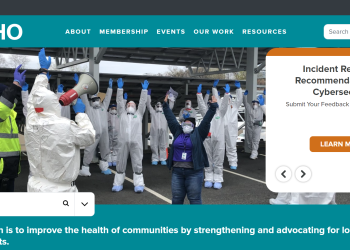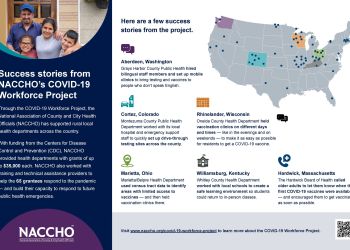FOR IMMEDIATE RELEASE
Contact:
Theresa Spinner
Director, Media and Public Relations, NACCHO
Direct: (202) 783-5551
[email protected]
Contact:
Max Mays
Communications Associate, BCHC
Direct: (913) 233-6830
[email protected]
Letter from the National Association of County and City Health Officials and the Big Cities Health Coalition
Washington, DC, August 27, 2020 -- On behalf of the nation’s local governmental public health departments, the National Association of County and City Health Officials and the Big Cities Health Coalition sent a letter to the Administration urging them to reverse changes to the Centers for Disease Control and Prevention’s (CDC) Overview of Testing for SARS-CoV-2 (COVID-19) guidelines published this week. The full letter can be found here.
As public health professionals, we are troubled about the lack of evidence cited to inform this change. CDC’s own data suggest that perhaps as many as 40 percent of COVID-19 cases are attributable to asymptomatic transmission. Changing testing guidelines to suggest that close contacts to confirmed positives without symptoms do not need to be tested is inconsistent with the science and the data.
Moreover, these changes in testing guidelines may have broad impacts on our ability to fight COVID-19. Not testing all possible close contacts impacts the ability of local health departments to engage in effective case investigation and contact tracing, the primary tools we have right now to slow the spread of this disease. While case investigations and contact tracing are important to address individual spread, local health departments use the data derived from these case investigations to identify not only who is developing COVID-19, but also where they contracted it. This allows them to not only alert others to their exposure to keep themselves and their family members or close contacts safe, but also to identify trends and hot spots that inform local policies and actions related to the primary transmission routes in their communities. Testing is not just about diagnostics, but also screening, and health departments need the data these tests provide in order to have a comprehensive view of community spread to make data-driven, evidence-based decisions around such critically important issues like opening our nation’s schools.
We recognize that the guidance does give deference to local and/or state health officials to make exceptions to the revised testing guidance. While it has been touted that this is to empower these leaders, in many ways, CDC’s guidance change will make their ability to respond to the pandemic even harder. Our members have stressed the vital importance of testing all close contacts and to do so with clear and consistent messaging. Without clear data backing up the rationale behind the revision, this change has put them in a position to say they will not be following the CDC guidelines.
We have seen over the months of the response the politization of public health, with local health officials and staff being blamed for taking the necessary steps to keep the public safe, being physically threatened with violence, and in some cases, fired for standing up for the public’s health. By removing the national recommendation and putting the decision-making squarely on individual leaders, it allows for skeptical elected officials and members of the public to again blame the individual public health leader who is simply trying to protect their health and safety. It may also lead to enhanced clashes with the health care system, as this type of guidance gives providers incredible leeway to make a clinical decision that may be supported by an individual patient’s situation, but not by the needs of the public’s health. We need to be clear and consistent. The new guidance is neither of those things.
While we are concerned about the data that was used to make this change and the impact it will have on the ability of our members to be effective in communities across the country, we are also concerned about the lack of transparency in both the development and rollout of the change. Our members appreciate their historically mutually beneficial and extremely supportive relationship with CDC, collaboratively working on issues from HIV to tuberculosis to Ebola. That relationship would, in the past, mean including local and state health official partners to help inform the revision process and pre-communicating a big change in guidelines. However, in this case, health officials were not given any warning this change was occurring or was posted on the website. No explicit communications were sent, leaving health officials to find out about the change via media inquiries. Our members have had to put out clarifying statements about whether/why they are testing who in their communities, and without evidence supporting the change, to contradict CDC’s suggestion.
Rather than empowering public health professionals and moving our nation forward in a cohesive way to address the pandemic, this abrupt change has caused confusion, consternation and undermined the credibility of the agency with public health professionals and the public alike. This revision and its resulting impact is adding yet another obstacle for public health practitioners to effectively address the pandemic. The lack of data supporting the change and the lack of communication about the change sows seeds of doubt in the public’s eyes and undercuts the dedicated career staff who are working day in and day out to support the response. This haphazard decision-making process is bad policy. It costs lives and livelihoods and impacts the standing of health officials across the country. Therefore, we urge you to pull the revised guidance and revert back to the previous consensus policy where people who may have been exposed to COVID-19 are encouraged to get tested, know their status, and do all they can to physically distance and stop the spread.
###
About NACCHO
The National Association of County and City Health Officials (NACCHO) represents the nation’s nearly 3,000 local health departments. These city, county, metropolitan, district, and tribal departments work every day to protect and promote health and well-being for all people in their communities. For more information about NACCHO, please visit www.naccho.org
About the Big Cities Health Coalition
The Big Cities Health Coalition (BCHC) is a forum for the leaders of America’s largest metropolitan health departments to exchange strategies and jointly address issues to promote and protect the health and safety of their residents. Collectively, BCHC member jurisdictions directly impact nearly 62 million people, or one in five Americans. For more information, visit http://www.bigcitieshealth.org.









